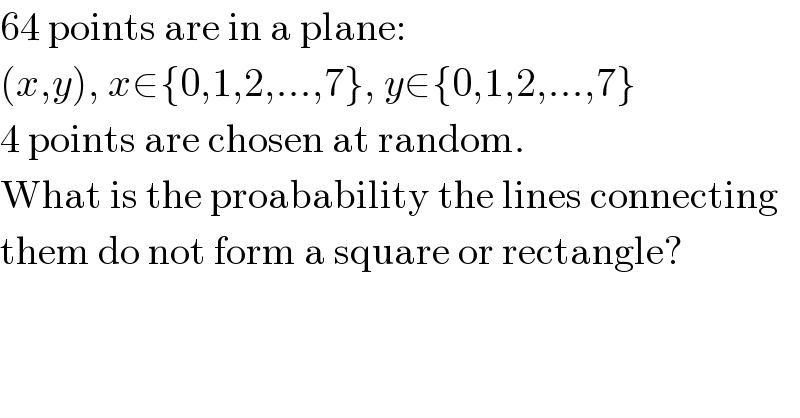Question Number 2771 by prakash jain last updated on 26/Nov/15

Answered by Rasheed Soomro last updated on 01/Dec/15
![Please Guide me if I am wrong. I don′t know much about PROBABILITY. Assuming that sides of rectangle are horizantal and vertical. Assuming that all vertices are different points. Being P_1 P_2 ^(−) horizantal, P_1 and P_(2 ) have same y−coordinate. For same reason P_3 and P_4 have same y−coordinate. Being P_1 P_4 ^(−) and P_2 P_3 ^(−) vertical, P_1 and P_4 have same x−coordinate, and P_2 and P_(3 ) have same x−coordinate. Let P_1 =(x_1 ,y_1 ),P_2 =(x_2 ,y_1 ),P_3 (x_2 ,y_2 ) and P_4 =(x_1 ,y_2 ) where x_i ∈{0,1,2,...,7},y_i ∈{0,1,2,...,7} We first consider possibility of being rectangle/square._(−) Possibility of cboosing P_1 ,P_2 ,P_3 and P_4 is Possibility of cboosing their coordinates x_1 ,y_1 ,x_2 and y_2 Choosing x_1 has (1/8) possibility and y_1 has (1/8) possibility. Hence choosing P_1 has (1/(64)) possibility. Choosing x_2 [≠x_1 ] after choosing x_1 has (1/7) possibility. Choosing x_1 ,y_1 and x_2 has (1/8)×(1/8)×(1/7) =(1/(448)) possibility. Choosing y_(2 ) after choosing y_1 has (1/7) possibility. Choosing all the coordinates x_1 ,y_1 ,x_2 and y_2 in succesion has (1/8)×(1/8)×(1/7)×(1/7)=(1/(3136)) possibility of being_(−) rectangle. Possibility of not being_(−) rectangle=1−(1/(3136))=((3135)/(3136))](https://www.tinkutara.com/question/Q2850.png)
Commented by prakash jain last updated on 04/Dec/15

Commented by Rasheed Soomro last updated on 30/Nov/15

Commented by Rasheed Soomro last updated on 03/Dec/15

Commented by prakash jain last updated on 04/Dec/15

Commented by Rasheed Soomro last updated on 04/Dec/15

